#west African traditions
Explore tagged Tumblr posts
Text
So I had a really cool conversation with my grandpa about Kru folklore and religion. While we’re talking, he explains why the Kru gravitated towards Christianity easier than other tribes.
Apparently, we aren’t animists?
Which is insane, since so many West African traditions are, including the Vai and Bassa (my mom’s people).
Our religion, instead has only two figures (I’ll call them that because I’m not comfortable mapping Christian terminology onto it). One is called Nyeswa, “One who brings fish” a benevolent force and the other is Ku the more malevolent force. These two figures are equal in power and are equally worshipped. Ku is more so appeased than revered so as to prevent him from lashing out on humans.
So my grandpa reasons that since this narrative fit closely with Christian tradition, the fact that “God” and “Satan” aren’t on the same playing field made more Kru accepting. It was comforting to have the “devil” figure be subject in some capacity to Nyeswa, freeing humans from the burden of appeasing him.
The more you know!
#Liberia#sassywood#west africa#west African traditions#reconnecting indigenous#african religions#liberian#christianity#mythology#folklore#not#yoruba#but tagging for exposure here#the last supper#Igbo#west african indigenous#black history
10 notes
·
View notes
Text
Exploring the Rich History of the Soninke People in Mali
Unveiling the Fascinating Soninke People of West Africa The Soninke people are an ethnic group with a rich cultural heritage deeply intertwined with the history of West Africa. This article delves into the fascinating world of the Soninke, exploring their origins, traditions, and the significant impact they had on the development of empires in the region. Whether you’re a history buff, an…
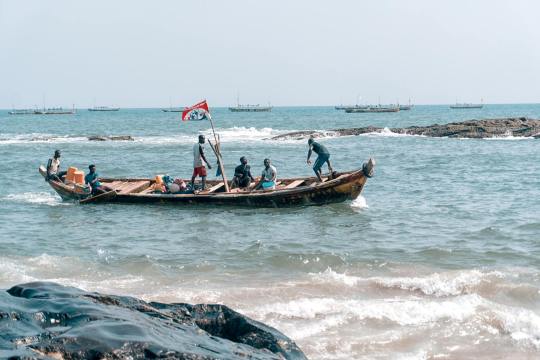
View On WordPress
#Cultural Diversity#Cultural Heritage#Cultural Influences#Cultural Tapestry#Ethnic Groups#Ghana Empire#Historical Significance#inclusivity#Interpretation Services#Language Access#Language Services#LanguageXS#Mande Language#Soninke Diaspora#Soninke Language#Soninke People#West Africa#West African Traditions
1 note
·
View note
Text
Anansi and the Pot of Wisdom
Once upon a time, in a small village, there lived a spider named Anansi. He was known throughout the land for his cleverness and cunning ways. Anansi was always looking for ways to gain more knowledge and power, and one day, he heard a rumor about a magical pot of wisdom that was hidden deep within the forest. Anansi couldn’t resist the temptation to possess such a pot, for he believed that…

View On WordPress
#Africa#African folklore#Anansi the Spider#animal friends#Caribbean traditions#cleverness#cunning spider#entertainment#jungle adventure#magical pot#sharing#valuable lessons#West African traditions#wisdom
0 notes
Text
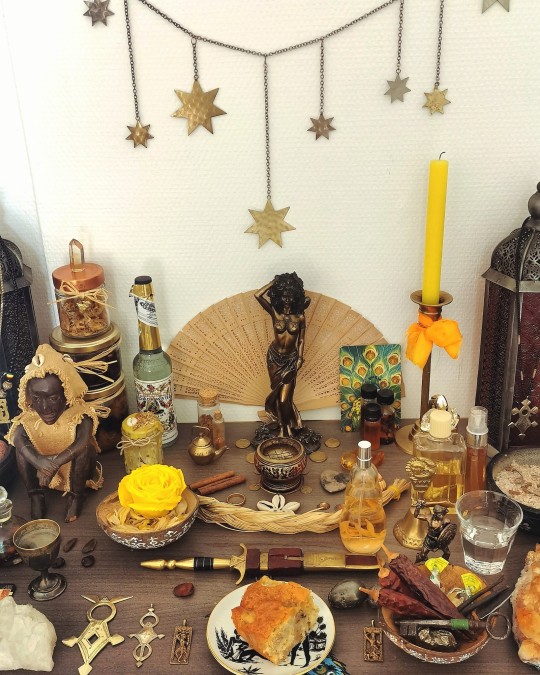
#oshungoddess#oshun#santeria#candomble#yoruba#ifa#aesthetic#atr#african traditional religions#orishas#ogun#hoodoo#african spirituality#afro witch#witches of color#west africa#florida water#oxum#keys#yellow flowers#iron#altar#my altar#offerings#blessings
212 notes
·
View notes
Text


This is a colourization I did of a Senegalese woman wearing traditional dress. The original b+w was taken by Mama Casset.
This took 3 hours to colourize.
I got the original b+w from @vintageeveryday
#africa#african#senegal#senegalese#black girl#black woman#african woman#west africa#history#black history#african history#traditional dress#colorization#colorized
124 notes
·
View notes
Text
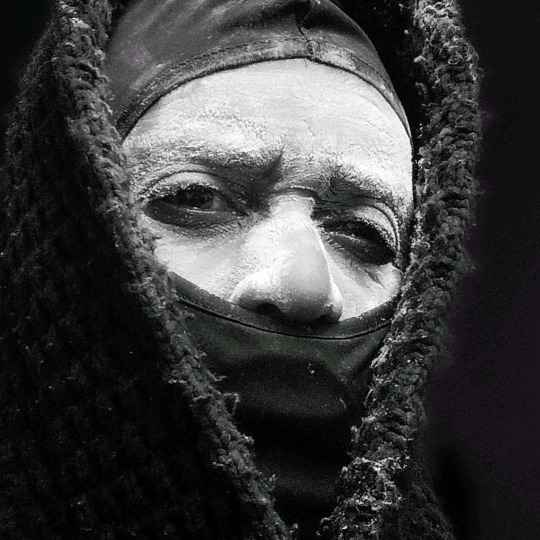
Jamaican Obeah
Jamaican Obeah refers to the practice of Obeah, a spiritual and magical tradition rooted in West African and Caribbean cultures. Obeah has a significance presence in Jamaica and holds cultural and historical importance on the island. Obeah in Jamaica has its roots in the spiritual beliefs and practices brought to the Caribbean through the transatlantic slave trade. Enslaved Africans brought with them a rich tapestry of religious and spiritual traditions, and Obeah emerged as a distinct syncretic practice in Jamaica. Individuals who practice Obeah are often referred to as "Obeah men" or "Obeah women". These practitioners have a deep understanding of the spiritual realm and are sought after for their abilities in healing, protection, divination and other spiritual services.
It's crucial to approach discussions about Jamaican Obeah with cultural sersitivity, recognizing the diversity of beliefs and practices within the Afro-Caribbean spiritual landscape. Different individuals and communities may have variations in their practices, and interpretations may differ among practioners. Respect for cultural beliefs and traditions is essential and fostering understanding.
#Obeah#Spiritual#Magical#Tradition#West African#Caribbean#Culture#History#Enslaved Africans#Syncretic Practice#Healing#Protection#Divination#Afro-Caribbean#Jamaica
75 notes
·
View notes
Photo
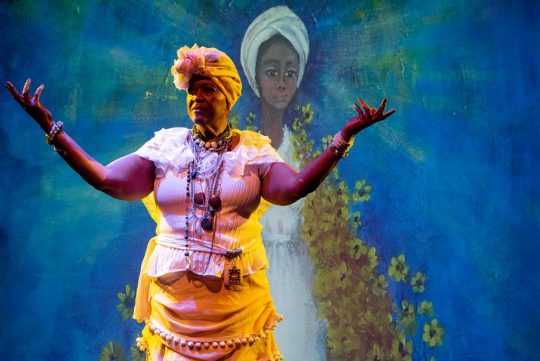
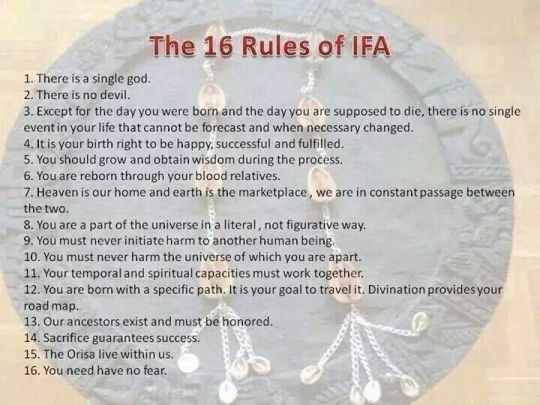
THE IFA CONCEPT OF SOCIOLOGY
Yoruba culture has used the Ifa paradigm of the cosmos as the basis for building their major cities. The structure of the Yoruba Nation was a federation of city states. Each city was ruled by an Oba. In ancient times the Oba was never seen by his subjects, so he became the invisible nucleus of the circle that formed the city. He was surrounded by a female council of elders called Odu and a predominantly male council of elders called Ogboni. The city itself was supported by male and female work parties who tended to divide their labor along gender lines. The men were traditionally farmers and the women traditionally controlled the market place. Both men and women participated in craft guilds that preserved the techniques used in the arts. The cities were built in a circular formation with the compound of the Oba at the center. The symbolic image of Yoruba culture appears as follows:
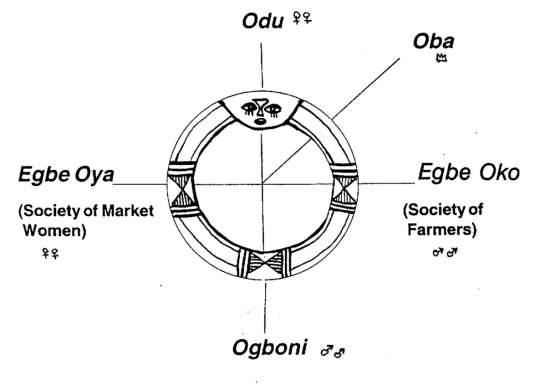
There is some archeological evidence in the Yoruba cities of Ile Ife and Oyo that suggests that this design was used as the basis for the actual layout of those cities. The extent to which this occurred in other cities has not been thoroughly researched. It does appear that this structure was used in pre-colonial times as the basis for establishing political and religious institutions both of which were built upon the cosmological model found in Ifa.
Variations on this structure involved the system of establishing the location for sacred shrines. The system is called Gede which is a very old form of astrology. In Gede the path of solar bodies and planets is marked in relationship to the ways that they transverse the landscape. Celestial bodies are believed to enhance the ase (inherent power) of natural forces that arise from the Earth. By correlating the influences of Olorun and Ile, the ancient diviners were able to consecrate their shrines in places that reflected the essence of specific Odu.
Earth (ile) was considered a reflection of Heaven (Orun) and the layout of Yoruba cities was designed to make them mirrors of the cosmic order. The religion of Ifa originally comes from the city of Ile Ife. In lfa scripture, Ile Ifa is described as the original home of humans. The words: "Ile Ife” translate to mean; "Spreading Earth." So Ile Ife is a city and it is any place where land formed on Earth that allowed for human evolution to take place. Ifa scripture also refers to Ile Ife as a Spiritual place. It is the home for those ancestors who have returned to Source.

D. THE IFA CONCEPT OF PSYCHOLOGY
Perhaps the most accessible manifestation of Odu is through the portal of individual consciousness. Ifa teaches that Odu represent the energy patterns that create consciousness. They are analogous to what Carl Jung called archetypes of the collective unconscious. Jung believed that there exists a set of primal patterns that form the content of self-perception and place the self in relationship to the world. According to Jung, these patterns remain abstract until the unconscious gives them a cultural and personal context. In both Jungian psychology and the Ifa concept of consciousness, Odu (archetypes) can be revealed through dreams, where they take on personal qualities and manifest as mythic drama. By grasping this particular manifestation of Odu, Ifa teaches that it is possible to create internal balance which is the foundation of living in harmony with Nature.
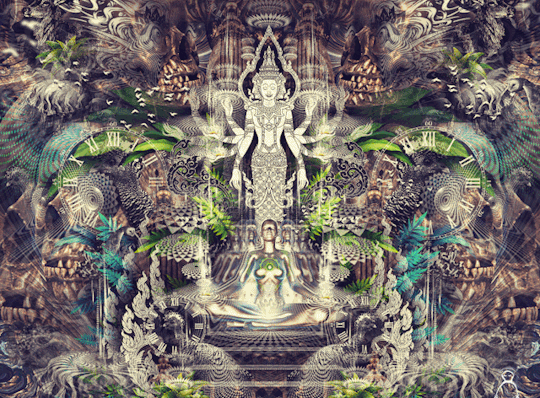
Ifa psychology is linked to the concept of ori. The literal translation of ori is "head." This is a limited definition because ori also implies consciousness and Ifa cosmology teaches that all Forces in Nature have ori or consciousness.31 Because Ifa believes in reincarnation, every ori forms a polarity with ipori. The ipori is the eternal consciousness that exists in Orun (Heaven).32 It is the ipori that forms the link between past and future lives. If a scripture describes the ipori as the perfect double of ori. According to Ifa cosmology, every ori makes an agreement with Olorun prior to each incarnation.33 This agreement outlines the type of life that is to be lived and the lessons that are to be learned in a given lifetime. At the moment of birth the content of this agreement is lost to conscious thought. Part of the process of establishing internal balance is viewed as the task of remembering the original agreement between ori and Olorun.

This agreement is the source of individual destiny. Because divination is considered a method for discovering destiny, all divination based on Ifa is related to the question of enhancing the alignment between ori and ipori.
The link between ori and ipori lies within ori inu.35 The Yoruba words; "ori inu" translate to mean; "inner head." This is a reference to what Jung called the individual consciousness or self. Ori inu is the nucleus of that circle of Forces that creates self-awareness.
In addition to the polarity between ori and ipori, ori inu is the center point of the polarity between ara and emi. Ara is the physical body. Ifa psychology includes the heart (okan) and the emotions (egbe) as part of the physical self. According to lfa, the nature of one's ipori can only be grasped if the head and the heart are in alignment. In other words, the mind and the emotions must be in agreement if spiritual insight is to occur. Similarly, Jung understood that a conflict between the mind and the emotions is one of the sources of mental illness.36 In Ifa this conflict is called ori ibi. It is difficult to make a literal translation of ori ibi, but the term suggests a lack of alignment between ori and ipori. When the ori and ipori are functioning as one, it creates a condition called ori ire. A literal translation of ori ire would be; "wise head." .Jung referred to this condition as individuation, which was his basis for defining mental health.37
Ara or the physical body exists in polarity with emi. The Yoruba word emi means; "breath.” Ifa teaches that the breath of life comes from Olodumare and contains the eternal essence of consciousness. Emi in this context would translate to mean; "soul." The Ifa symbol of self would appear as follows:


#ifa#vodun#kemetic dreams#traditional african religion#african spirituality#african culture#west africa#odunlade adekola#ori#orunmila#oya
496 notes
·
View notes
Text
West African countries such as Liberia, Senegal and Guinea-Bissau, communities have designated biodiversity hotspots, including forests and lagoons, as sacred. This system has served as a conservation tool respected by these communities for generations. The community's existence is intricately linked to the well-being and survival of the biodiversity and natural resources surrounding it.
The Western African method is to reinforce communal stewardship of the land, rather than ownership. The system starkly contrasts with some current, non-Indigenous North American methods of prohibiting humans from living in certain protected areas. Placing a dollar value on conserving these areas risks destroying the very belief system and way of thinking that have ensured their survival in the first place. Their value of biodiversity cannot be translated into monetary terms.
#biodiversity#west africa#environmentalism#habitat preservation#african#africa#biology#culture#liberia#senegal#guinea bissau#traditional culture#african tribe#conservation#sacred land#logging company#protected land
99 notes
·
View notes
Text


Traditional dress of the Woodabe tribe in Niger
#african#woodabe#africa#nigeria#niger#chad#west africa#folk costume#vintage photography#photography#traditional wear#traditional costume#folk costumes#folk fashion
12 notes
·
View notes
Text
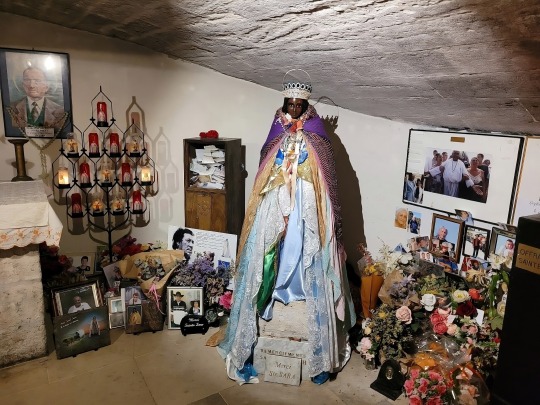

the shrine of saint sarah in the church of the saintes-maries-de-la-mer in in the camargue in france. the church itself was built in the 9th century and named for and dedicated to the three marys. a popular french legend goes that they and their maid, sarah, landed on a camargue coast.
saint sarah, or sarah-e-kali (sarah the black, “the black” is a title sometimes given to black/dark-skinned saints) in romani, is the patron saint of roma people in latin catholicism, though she isn't recognized by the catholic church. she is also revered as a protector for marginalized and poor people in general. her origins are thought to lie in a syncretization of the hindu goddess kali, the story of sarah along with the three marys, and the tradition of black madonnas. (christian roma have historically venerated other black madonnas as well.) the church is her major shrine - she's venerated here annually on the 24th of may by roma pilgrims.
#france#romani#interior#worship#christian#my posts#brahmic (hindu buddhist etc) deities are syncretized into a bunch of very specific forms depending on where you look#and one can have a bunch of different forms that are ultimately the same being/idea#it fits perfectly into the concept of saints if you think about it#not that people think saints are gods but the like. manifestations thing#i think there's some syncretic christianity/west african religions/hindu traditions in places 18th/19th century enslaved indians#were shipped to (mostly in central/south america which has a big history of syncretic christianity in general)
22 notes
·
View notes
Text

🫧 mermay 2024 // day 20: Freetown, Liberia 🫧
“tenneh” 🧜🏿♀️🇱🇷
ig: badmotorartist
#mermay#mermay 2024#mermay prompts#mermay around the world#mermaid art#mermay art#merfolk#traditional art#traditional drawing#sepia#colored pencils#colored pencil#white charcoal#africa#west africa#african art#liberia#freetown#artists on tumblr#badgalnirvhannahart#Spotify
8 notes
·
View notes
Text
Klao Lesson #4: Food - Di gba dey

Food - Di gba dey (The thing you eat in the house)
Rice - koh
Fufu - fufu
Palaver sauce - kpelleh-toe
Palmbutter - chuh
Peppeh/Pepper - bah?
Cassava - sokoloh?
Cassava Leaf - sokoloh weh
Mango - plunh
What did you eat today - Deben di dey da?
I ate () today: Nenh di () dey da
I didn’t eat (Good morning): Sekeh de Di (nye tanah)
Did you eat my (food)? - di na (food)
Cook - Pinh
Cook for me - Pinh co-um-bo.
Cook something for me - Pinh de co-um-bo
Cook palmbutter for me - Pinh chuh co-um-bo
#i have obligations#West African indigenous#west african traditions#food#learning a language#indigenous langblr#klao lessons
3 notes
·
View notes
Text
one super interesting thing i keep running into while gathering references of historical clothing from across the world is while you would imagine that those clothes are super different across cultures, you kinda end up running into super similar elements the world over. like, ive looked at historical dress of north africa, western europe, eastern europe, and to a lesser degree various parts of asia and africa (i do tend to mostly take inspiration from the mediterranean and the slavic - i also dont tend to pick from indigenous american stuff too much as it is kind of the exception where i see a lot less overlap and it feels a lot more dicey to lift from those sources when the inspiration would become a lot more obvious and come w implications of coding and appropriation i dont feel equipped to tackle) and kept seeing things reappear. layered skirts and aprons, short vests over blouses, jewelry over the chest in layers of metal circles, hair coverings... in a way it makes total sense, people come up w the same thing everywhere bc people have the same bodies to accomodate everywhere so it just makes sense, but its also rly rly fun to be like "this traditional russian costume has so much in common w traditional north african costumes" yknow? it also rly helps to define general trends across geography and history when designing fictional traditional clothing bc i can mix and match the elements i like most and still end up w something that looks real and tangible. thats what i did for ajdig (that one comic i made for my grandma) - the original refs for the character designs came from all over the world but i think when you look at them you feel like these are the real clothes of a people
#97#ive definitely had the experience of looking at like.#traditional slavic garments and going 'that looks a lot like some traditional amazigh garbs'#despite the vast geographical difference theres still those similarities!#i find that a lot in embroidery as well as its an interest of mine - patterns that seem v similar#sometimes bc theyre just so evident to come up w in the medium of embroidery that they show up all over the place#same is true for resemblances between various writing systems that use v geometric shapes!#like. tamazight ogham and slavic runes have a lot of symbols that look like they could all go together.#also its v hard to find good sources of historical clothing of subsaharan africa (dont love that classification either but.)#everything is mixed (you look up west african stuff and end up w east african stuff etc) and actual historical dress is harder to find than#modern garb which is awesome but i AM looking for OLD stuff regardless of the region#and my searches keep somehow finding stuff from north africa? which i think is the algorithm being poisoned by my previous searches#but its still quite annoying#like if im looking 'historical clothing burundi' im NOT looking for algerian stuff.
4 notes
·
View notes
Text

2 notes
·
View notes
Text

"Le miel d'Oshun", acrylic on paper, 21 x 29,7 cm
Instagram : @jenekacy_art
#oshungoddess#oshun#oshunenergy#acrylicpainting#illustration#acrylicillustration#witches of color#santeria#africanart#ifa#west africa#yoruba#candomble#my art#contemporary art#hoodoo#honey#love goddess#afrofantasy#afro witch#africanspirituality#african traditional religions#african spirituality#oxum
33 notes
·
View notes
Text

The traditional origins of twerking!🍑
🎶🇨🇮🎶
#history#mapouka#dance#côte d’ivoire#music#african history#dabou#fertility#traditional femininity#1990s#twerking#just girly things#black coquette#black girl magic#african women#dance history#west africa#rap#precolonial#traditional practices#black femininity#coquette#womens history#zouglou music#african culture#nickys facts
5 notes
·
View notes